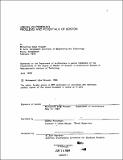| dc.contributor.advisor | Dennis Frenchman. | en_US |
| dc.contributor.author | Hossain, Mohammad Iqbal | en_US |
| dc.contributor.other | Massachusetts Institute of Technology. Dept. of Architecture. | en_US |
| dc.coverage.spatial | n-us-ma | en_US |
| dc.date.accessioned | 2012-11-19T19:04:59Z | |
| dc.date.available | 2012-11-19T19:04:59Z | |
| dc.date.copyright | 1984 | en_US |
| dc.date.issued | 1984 | en_US |
| dc.identifier.uri | http://hdl.handle.net/1721.1/74758 | |
| dc.description | Thesis (M.S.)--Massachusetts Institute of Technology, Dept. of Architecture, 1984. | en_US |
| dc.description | MICROFICHE COPY AVAILABLE IN ARCHIVES AND ROTCH | en_US |
| dc.description | Includes bibliographical references. | en_US |
| dc.description.abstract | The essence of this thesis is based on the fact that downtown waterfronts are special urban areas in a city. These areas offer unique opportunities for providing cultural and recreational public amenities to urban life. The important difference between water as a natural resource and water as an urban amenity lies in the relationship of water with the urban form. In downtown waterfronts two opposite forces confront each other. From the landside urban land use. transportation network and real estate speculations compete against the waterside forces of water related activities and the right of public to use the waterfront for recreation and other activities. Finding the balance between these two forces is the key to successful use of downtown waterfronts. This thesis examines the prospect of finding a balance for the development of Boston's downtown waterfront. The problems and potentials of Boston's waterfront is analyzed first to form the basis for evaluating the existing and proposed development plans on the waterfront. The results of more than two decades of development activities have left Boston's waterfront short of the balance which makes the difference between the waterfront as an enjoyable public area and the waterfront as an overbuilt extension of downtown urban fabric. The implications of the existing and proposed developments are analyzed to assess the future of Boston's waterfront. The synthesis of this analysis identifies the major concerns for the present and future development activities and formulates the directions and guidelines for developments. These guidelines are proposed as broad based outlines and illustrated examples of critical spot are provided as images of developments following the guidelines. | en_US |
| dc.description.statementofresponsibility | by Mohammad Iqbal Hossain. | en_US |
| dc.format.extent | 77 leaves | en_US |
| dc.language.iso | eng | en_US |
| dc.publisher | Massachusetts Institute of Technology | en_US |
| dc.rights | M.I.T. theses are protected by
copyright. They may be viewed from this source for any purpose, but
reproduction or distribution in any format is prohibited without written
permission. See provided URL for inquiries about permission. | en_US |
| dc.rights.uri | http://dspace.mit.edu/handle/1721.1/7582 | en_US |
| dc.subject | Architecture. | en_US |
| dc.title | Urban waterfront : problems and potentials of Boston | en_US |
| dc.type | Thesis | en_US |
| dc.description.degree | M.S. | en_US |
| dc.contributor.department | Massachusetts Institute of Technology. Department of Architecture | |
| dc.identifier.oclc | 11709548 | en_US |
